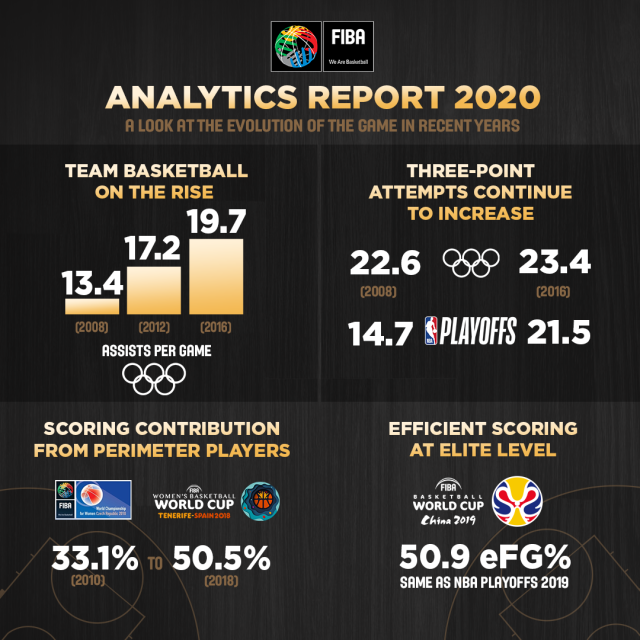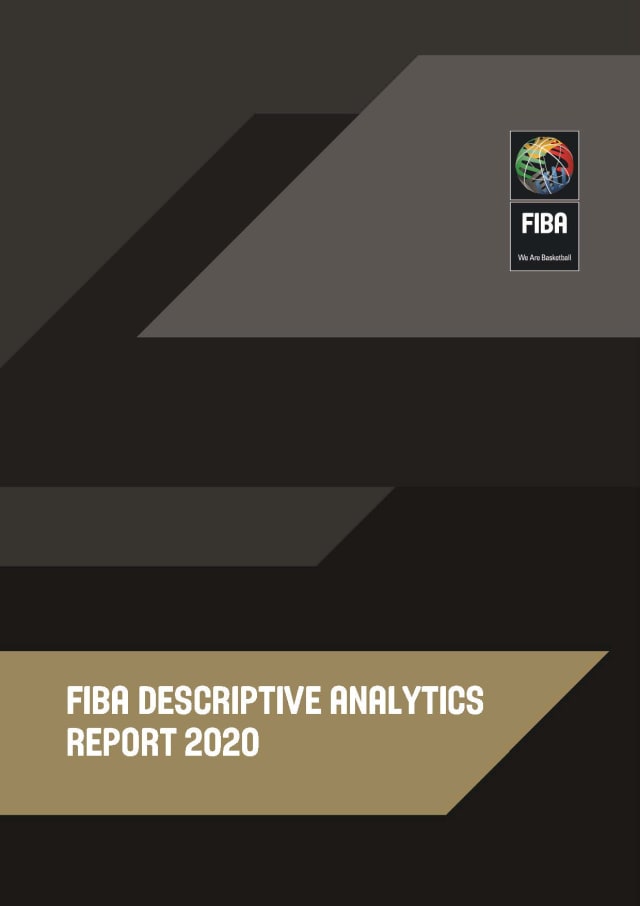FIBA and WABC highlight global basketball trends in latest descriptive analytics report
MIES (Switzerland) - The FIBA Descriptive Analytics Report 2020, developed by FIBA and the World Association of Basketball Coaches (WABC), has been published.
MIES (Switzerland) - The FIBA Descriptive Analytics Report 2020, developed by FIBA and the World Association of Basketball Coaches (WABC), has been published.
The report looks into team and individual player analysis at the most recent FIBA events at international level. Through collaboration with the NBA, comparative analysis with WNBA and NBA analytics has also been included.
The aim of the report is to provide a broad overview of key performance indicators in the FIBA U17 and U19 Men's and Women's Basketball World Cups, FIBA Senior Men's and Women's Basketball World Cups and Men's and Women's Olympic Basketball Tournaments, as well to offer insights for both senior and junior coaches in developing their athletes and teams to higher levels of competition.

Some of the main highlights from the report are as follows:
Three-point attempts continue to increase across youth & senior game
There has been a growing trend in almost all forms of international competition in regard to the number of three-point attempts per game. There has been a small rise at the Men's Olympics from 22.6 in 2008 to 23.4 in 2016 with the NBA Playoffs now more in line with those numbers having jumped from 14.7 in 2008 to 21.5 in 2016.
Both the U19 Men's and Women's World Cups have seen increased numbers of three-point attempts over the last five editions, while the three-point percentage was at its highest at the 2016 Women's Olympics though attempts have fluctuated.
More efficient scoring at the elite level
The overall eFG percentage, which takes into account the different values of two-point and three-point field goal attempts, at the FIBA Basketball World Cup 2019 was exactly the same as during the 2019 NBA Playoffs, at 50.9 percent having seen minimal differences in favour of the FIBA competition in 2010 and 2014.
The overall eFG percentage has also increased at both the Women's Olympics and the WNBA Playoffs with the numbers at its highest in 2016 compared to previous editions in 2008 and 2012.
Distribution of points by position is evolving
The percentage of points scored by both guards and perimeter players at the FIBA Women's Basketball World Cup has increased from 33.1 percent in 2010 to 50.5 percent at the recent edition in 2018, while the percentage of points scored by bigs decreased from 66.9 percent to 49.4 percent.
While that percentage has been more consistent at the men's FIBA Basketball World Cup, an increase in the percentage of points scored by players in the perimeter positions has also been recorded. In 2019, perimeter players accounted for 28.4 percent of all points scored, up from 17.2 percent in 2010.
Emphasis on team basketball and taking care of the ball
The number of assists at the Men's Olympics have continued to rise, having increased from 13.4 in 2008 to 17.2 in 2012 and 19.7 in the most recent edition in 2016.
Meanwhile, at the FIBA U17 Women's Basketball World Cup, turnover numbers have fallen with a gradual decrease in each of the past four editions from 20.4 in 2012 to 17.8 in 2018.
Rise in the number of close games at the Men's World Cup
Of the last three FIBA Basketball World Cups, the 2019 edition saw the highest percentage of close games - decided by six points or less - with 34.9 percent of the 92 total games, whilst also seeing a drop in the percentage of games won/lost by more than 14 points.
###
About FIBA
FIBA (fiba.basketball) - the world governing body for basketball - is an independent association formed by 213 National Basketball Federations throughout the world. It is recognized as the sole competent authority in basketball by the International Olympic Committee (IOC).
For further information about FIBA, visit fiba.basketball or follow FIBA on facebook.com/fiba, twitter.com/fiba, instagram.com/fiba and youtube.com/fiba.
 Click to read the full report
Click to read the full report